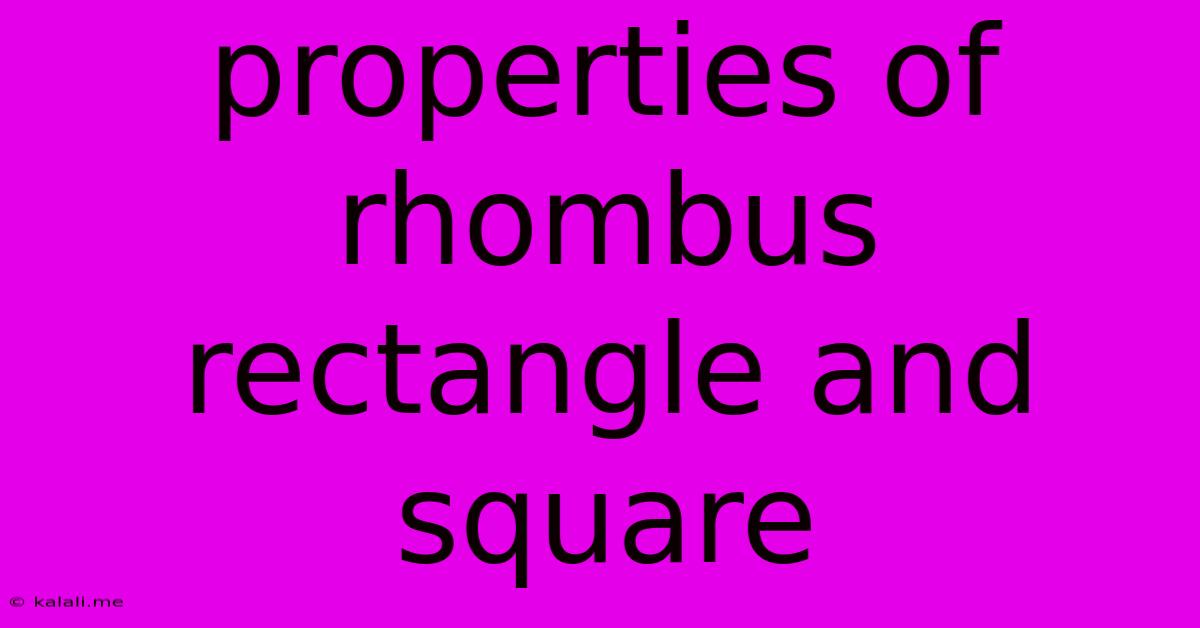Properties Of Rhombus Rectangle And Square
Kalali
May 09, 2025 · 3 min read

Table of Contents
Exploring the Properties of Rhombuses, Rectangles, and Squares
Understanding the properties of rhombuses, rectangles, and squares is fundamental to geometry. These shapes, all belonging to the broader category of quadrilaterals, share some characteristics while possessing unique defining features. This article will delve into the individual properties of each shape, highlighting their similarities and differences, and explaining how squares act as a special case encompassing the properties of both rhombuses and rectangles.
What defines a quadrilateral?
Before diving into the specifics of rhombuses, rectangles, and squares, let's establish a common ground. A quadrilateral is any polygon with four sides and four angles. The sum of the interior angles of any quadrilateral always equals 360 degrees. Our focus here will be on special quadrilaterals with specific angle and side properties.
Rhombus: The Equal-Sided Quadrilateral
A rhombus is a quadrilateral where all four sides are of equal length. This is its defining characteristic. Let's explore its other key properties:
- Opposite sides are parallel: This means a rhombus can also be classified as a parallelogram.
- Opposite angles are equal: The angles opposite each other are congruent.
- Consecutive angles are supplementary: This means that any two angles next to each other add up to 180 degrees.
- Diagonals bisect each other at right angles: The lines connecting opposite corners cut each other in half and form four right angles (90 degrees) where they intersect.
- Diagonals bisect the angles: Each diagonal splits its corresponding angles into two equal angles.
Rectangle: The Right-Angled Quadrilateral
A rectangle is a quadrilateral where all four angles are right angles (90 degrees). Its defining characteristic distinguishes it from other quadrilaterals. Key properties include:
- Opposite sides are equal and parallel: Like a rhombus, a rectangle is also a parallelogram.
- Diagonals bisect each other: Unlike a rhombus, the diagonals don't necessarily bisect the angles, though they are equal in length.
Square: The Perfect Quadrilateral
A square is arguably the most symmetrical quadrilateral. It combines the properties of both a rhombus and a rectangle, making it a unique and special case.
- All four sides are equal: This property is inherited from the rhombus.
- All four angles are right angles (90 degrees): This property is inherited from the rectangle.
- Opposite sides are parallel: Inherits this property from both rhombus and rectangle.
- Diagonals bisect each other at right angles: It inherits this property from the rhombus.
- Diagonals are equal in length and bisect the angles: This is a combination of properties from both the rhombus and the rectangle.
The Hierarchy of Shapes
It's helpful to visualize the relationship between these shapes as a hierarchy:
- Quadrilaterals are the broadest category.
- Parallelograms are quadrilaterals with opposite sides parallel. Rhombuses and rectangles are types of parallelograms.
- Rhombuses are parallelograms with all sides equal.
- Rectangles are parallelograms with all angles equal to 90 degrees.
- Squares are both rhombuses and rectangles, possessing all the properties of both. A square is a special type of rhombus and a special type of rectangle.
Understanding these properties is crucial for solving geometrical problems, particularly those involving area calculations, angle measurements, and proofs. By grasping the defining characteristics and relationships between rhombuses, rectangles, and squares, one can effectively navigate a range of geometric challenges.
Latest Posts
Latest Posts
-
6 Out Of 17 As A Percentage
May 09, 2025
-
Cuantos Metros Son 6 Pies De Altura
May 09, 2025
-
What Is 75 Percent Of 16
May 09, 2025
-
What Is 60 Of 75 Of 60
May 09, 2025
-
What Is 12 7 Mm In Inches
May 09, 2025
Related Post
Thank you for visiting our website which covers about Properties Of Rhombus Rectangle And Square . We hope the information provided has been useful to you. Feel free to contact us if you have any questions or need further assistance. See you next time and don't miss to bookmark.